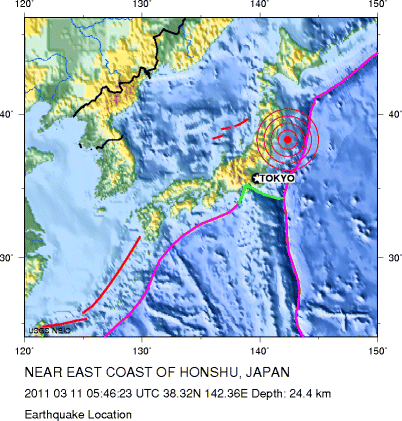Tsunami in Japan 2011: Waves Stirred Up by Earthquake Cause Wide Destruction

Learn about the science behind tsunamis and earthquakes
by Beth Rowen and Catherine McNiff
 Location of the earthquake. Source: U.S. Geological Survey |
Related Links
|
Tsunami in Japan
Japan was hit by a 9.0 magnitude earthquake on March 11, 2011, that triggered a deadly 23-foot tsunami in the country's north. The giant waves deluged cities and rural areas alike, sweeping away cars, homes, buildings, a train, and boats, leaving a path of death and devastation in its wake. Video footage showed cars racing away from surging waves. The earthquake—the largest in Japan's history—struck about 230 miles northeast of Tokyo. The Pacific Tsunami Warning Center issued warnings for Russia, Taiwan, Hawaii, Indonesia, the Marshall Islands, Papua New Guinea, Australia, and the west coasts the U.S., Mexico, Central America, and South America. According to the official toll, the disasters left 15,839 dead, 5,950 injured, and 3,642 missing.
Earthquake Causes Nuclear Disaster
What's more, cooling systems in one of the reactors at the Fukushima Daiichi Nuclear Power Station in the Fukushima prefecture on the east coast of Japan failed shortly after the earthquake, causing a nuclear crisis. This initial reactor failure was followed by an explosion and eventual partial meltdowns in two reactors, then by a fire in another reactor which released radioactivity directly into the atmosphere. The nuclear troubles were not limited to the Daiichi plant; three other nuclear facilities also reported problems. More than 200,000 residents were evacuated from affected areas.
On April 12, Japan raised its assessment of the situation at the Fukushima Daiichi nuclear power plant to Level 7, the worst rating on the international scale, putting the disaster on par with the 1986 Chernobyl explosion. Developed by the International Atomic Energy Agency (IAEA) along with countries who use nuclear energy, the scale defines level 7 as a nuclear accident that involves "widespread health and environmental effects" and the "external release of a significant fraction of the reactor core inventory." Almost two months later, the IAEA called the status of the Fukushima Daiichi nuclear plant "very serious."
At a news conference on March 13, Prime Minister Naoto Kan, who later gave the disaster the name "Great East Japan Earthquake", emphasized the gravity of the situation: "I think that the earthquake, tsunami, and the situation at our nuclear reactors makes up the worst crisis in the 65 years since the war. If the nation works together, we will overcome." The government called in 100,000 troops to aid in the relief effort. The deployment was the largest since World War II.
The tsunami in Japan recalled the 2004 disaster in the Indian Ocean. On Dec. 26, a 9.0 magnitude earthquake—the largest earthquake in 40 years—ruptured in the Indian Ocean, off the northwest coast of the Indonesian island of Sumatra. The earthquake stirred up the deadliest tsunami in world history, so powerful that the waves caused loss of life on the coast of Africa and were even detected on the East Coast of the United States. More than 225,000 people died from the disaster, a half a million were injured, and millions were left homeless.
See statistics on Deadliest Tsunamis and Deadliest Earthquakes.
The Science of Tsunami
A tsunami (pronounced soo-NAHM-ee) is a series of huge waves that occur as the result of a violent underwater disturbance, such as an earthquake or volcanic eruption. The waves travel in all directions from the epicenter of the disturbance. The waves may travel in the open sea as fast as 450 miles per hour. As they travel in the open ocean, tsunami waves are generally not particularly large—hence the difficulty in detecting the approach of a tsunami. But as these powerful waves approach shallow waters along the coast, their velocity is slowed and they consequently grow to a great height before smashing into the shore. They can grow as high as 100 feet; the Indian Ocean tsunami generated waves reaching 30 feet.
Tsunami is the Japanese word for "harbor wave." They are sometimes mistakenly referred to as tidal waves, but tsunamis have nothing to do with the tides. Tsunamis have been relatively rare in the Indian Ocean, and are most common in the Pacific Ocean.
For more details on Tsunami, see our encyclopedia article and Tsunami FAQs.
Tsunamis and Earthquakes: Facts and Stats | Nuclear Accidents: Facts and Stats |
| Fatalities | Year | Magnitude | Principal areas |
|---|---|---|---|
| 350,000 | 2004 | 9.0 | Indian Ocean |
| 100,000 | 1410 b.c. | Crete-Santorini, Ancient Greece | |
| 100,000 | 1755 | 8.5 | Portugal, Morocco, Ireland, and the United Kingdom |
| 100,000 | 1908 | Messina, Italy | |
| 40,000 | 1782 | 7.0 | South China Sea, Taiwan |
| 36,500 | 1883 | Krakatau, Indonesia | |
| 30,000 | 1707 | 8.4 | Tokaido-Nankaido, Japan |
| 26,360 | 1896 | 7.6 | Sanriku, Japan |
| 25,674 | 1868 | 8.5 | Northern Chile |
| 15,030 | 1792 | 6.4 | Kyushu Island, Japan | Source: National Geophysical Data Center, National Oceanic and Atmospheric Administration. |
| Fatalities | Year | Magnitude | Principal areas |
|---|---|---|---|
| 830,000 | 1556 | 8.0 | Shansi, China |
| 255,000+ | 1976 | 8.0 | Tangshan, China |
| 230,000+ | 2004 | 9.1 | off west coast of northern Sumatra |
| 230,000 | 1138 | n.a. | Aleppo, Syria |
| 222,570 | 2010 | 7.0 | Haiti |
| 200,000 | 1920 | 8.6 | Gansu, China |
| 200,000 | 1927 | 7.9 | near Xining, China |
| 200,000 | 856 | n.a. | Damghan, Iran |
| 150,000 | 893 | n.a. | Ardabil, Iran |
| 143,000 | 1923 | 7.9 | Kwanto, Japan |
| 87,587 | 2008 | 7.9 | Sichuan, China |
Source: National Earthquake Information Center, U.S. Geological Survey. Data compiled from several sources. | |||







